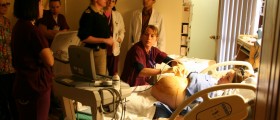
Statistical Data about Neural Tube Defects
The two most common causes of infant and fetal mortality are spina bifida and anencephaly. There are several thousand fetuses in America affected by such neural tube defects each year. There are one third of such cases which end up with elective or spontaneous abortion. Anencephaly is a terrible disease which is associated with stillborn infants or infants who die shortly after their birth. Spina bifida is not that severe because there are many children affected by it who still manage to survive due to extensive surgical and medical care. It is very hard to determine any long term prognosis because certain medical complications can be managed much more efficiently with modern technology. Infants affected by spina bifida whose defect gets surgically repaired shortly after they are born have a high rate of survival into their third decade in life. These survivors of spina bifida are very likely to suffer from certain severe types of disabilities and they also often have troubles manifested as psychosocial maladjustment. Various neurological defects or the repairs of them such as syringobulbia, syringomyelia, tethered cord, endocrine abnormalities, Arnold-Chiari type II malformation, hydrocephalus and paralysis may also be present. Certain types of neurologic deficits may additionally occur and these may involve learning disabilities, sexual dysfunction, bowel dysfunction, bladder dysfunction and deformation of the limbs and the spine. Spina bifida is obviously associated with certain emotional issues but it is also involved in a substantial monetary cost. The total cost of a single case of spina bifida over the lifetime of a person is approximately 294,000 dollars. Each year, one out of 1,000 pregnancies gets affected either by spina bifida or anencephaly. These medical conditions are known of ever since the beginnings of mankind, but the recent years have shown a significant progress in terms of prevention and proper treatment options. Fortunately enough, the modern science and technology has made it possible for at least half of cases of neural tube defects to be prevented effectively. The best way of prevention is intake of prescribed doses of folic acid supplements one month before the conception and during the first three months of the pregnancy. The suggested daily recommendations for folic acid are 400 micrograms, while pregnant women need to take 600 micrograms. There are also certain new strategies for prevention still in the developmental phases in the fields of molecular genetics, developmental biology and biochemistry. In spite of all the developments and measures of prevention the exact cause of neural tube defects is still largely unknown in most cases.
Genetic and Environmental Causes
Causes of neural tube defects may be described either as genetic or environmental ones. According to certain scientific studies, there is a geographic and temporal variability which may be associated with the occurrence of neural tube defects. They may also be associated with a socioeconomic status, ethnic background and race of a woman in question. In some cases, both genetic and environmental factors are combined so that neural tube defects occur. There have also been certain epidemics of neural tube defects which significantly add to the seriousness of the environmental causes. Certain variations in rates of racial or ethnic background associated with neural tube defects is nearly impossible to follow and can only be interpreted in a rather complex way. Groups of people with a significantly lower socioeconomic status are commonly at higher risk of having pregnancies affected by different sorts of neural tube defects. It is rather difficult to identify any specific factors associated with the development of neural tube defects. Among the rare ones which have been identified up to date, they are obesity, hyperthermia in early pregnancy, fever in early pregnancy, maternal use of different sorts of antiepileptic drugs and medicaments and maternal diabetes. One of the obvious candidates among the causes of neural tube defects includes poor nutrition as one of the most common ones. Nutrition is a rather variable parameter and it varies greatly among different social classes, cultures and countries.
Treatment Options
Neural tube defects occur once the neural tissues get damaged due to exposure to certain types of toxic substances in the amniotic fluid and also because of the occurrence of trauma to the neural tissue triggered by contact with the birth canal and the uterine wall. Spina bifida may sometimes be treated by utilizing a surgical intervention in the uterus, but only if the surgery is performed within 22 weeks since the gestation occurred. There are always experiments and new options but all cases of neural tube defects are rather complex and present quite a challenge for the modern medicine and its technology. The problem with spina bifida is that it often may trigger the onset of several other medical conditions such as skin ulcerations, calculi, urinary tract infections and so on.

















Your thoughts on this
Loading...